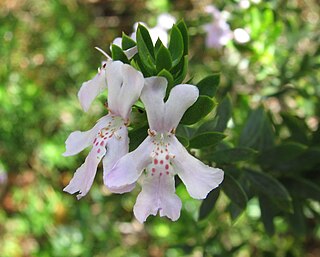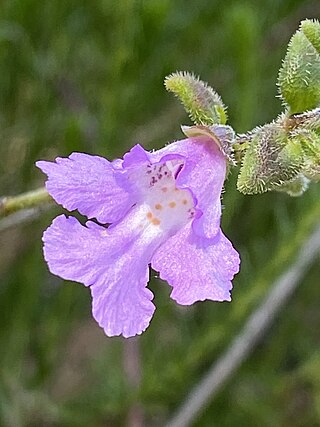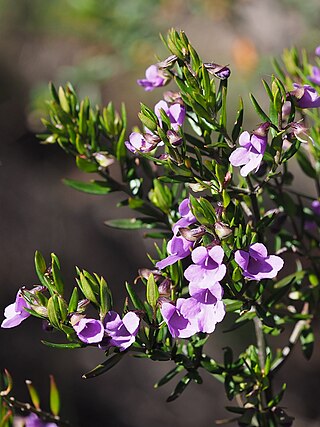
Prostanthera incisa, commonly known as cut-leaf mint-bush or native thyme, is a species of flowering plant in the family Lamiaceae and is endemic to south-eastern continental Australia. It is an erect, strongly aromatic, openly branched shrub with hairy, densely glandular branches, egg-shaped to oblong leaves, and pale mauve to mauve flowers.

Prostanthera rotundifolia, commonly known as round-leaved mintbush or round-leaf mint-bush is a species of flowering plant in the mint family Lamiaceae, and is endemic to south-eastern Australia. It is an erect shrub with aromatic branches covered with short hairs and glands, egg-shaped to more or less round leaves and purple to mauve or pinkish flowers on the ends of branchlets.

Dampiera stricta commonly known as blue dampiera, is a flowering plant in the family Goodeniaceae. It is a small sub-shrub with variable leaves and mostly blue, mauve or purple flowers.

Prostanthera linearis, commonly known as narrow-leaved mint-bush is a species of flowering plant in the family Lamiaceae and is endemic to eastern Australia. It is an erect, faintly aromatic shrub with glabrous, narrow egg-shaped to linear leaves and white flowers that are often tinged with pinkish-mauve.

Westringia glabra, commonly known as violet westringia, is a flowering plant in the family Lamiaceae and is endemic to Australia. It is a small shrub with oval-shaped leaves and pinkish, mauve or purple flowers.

Prostanthera marifolia, commonly known as Seaforth mintbush, is a species of flowering plant that is endemic to a restricted area of New South Wales. It is a small, erect, openly branched shrub with egg-shaped to elliptic leaves, and purple to mauve flowers arranged in leaf axils.

Prostanthera rhombea, commonly known as sparkling mint-bush, is a plant in the family Lamiaceae and is endemic to disjunct areas of south-eastern Australia. It is an openly-branched shrub with strongly aromatic branches, circular to heart-shaped leaves and mauve or bluish flowers.

Prostanthera denticulata, commonly known as rough mint-bush, is a species of flowering plant in the family Lamiaceae and is endemic to coastal New South Wales. It is a straggling to almost prostrate, aromatic shrub with narrow egg-shaped leaves and purple to mauve flowers arranged in leaf axils or on the ends of branchlets.

Prostanthera saxicola is a species of flowering plant in the family Lamiaceae and is endemic to eastern Australia. It is a shrub with linear to elliptic leaves and white to mauve flowers arranged in leaf axils.

Prostanthera serpyllifolia, commonly known as small-leaved mint-bush, is a species of flowering plant in the family Lamiaceae and is endemic to southern Australia. It is a small shrub with small egg-shaped leaves and bright pink to red or metallic bluish-green flowers.

Prostanthera caerulea, commonly known as lilac mint bush, is a species of flowering plant that is endemic to eastern Australia. It is an erect shrub with narrow egg-shaped leaves that have toothed edges, and white to bluish mauve flowers arranged on the ends of branchlets.

Prostanthera prunelloides is a species of flowering plant in the family Lamiaceae and is endemic to eastern New South Wales. It is a shrub with four-ridged branches, egg-shaped to round leaves and white or pale mauve flowers.

Prostanthera scutellarioides is a species of flowering plant that is endemic to New South Wales. It is an erect, or low-lying, faintly aromatic shrub with linear leaves and pale to deep mauve flowers arranged in leaf axils.

Prostanthera violacea, commonly known as violet mint-bush, is a species of flowering plant in the family Lamiaceae and is endemic to south-eastern New South Wales. It is a slender, strongly aromatic shrub with densely hairy branches, more or less round leaves with the edges rolled under and mauve to bluish flowers often with white tips.

Westringia longifolia, commonly known as long-leaved westringia, is a flowering plant in the family Lamiaceae and is endemic to southeastern Australia. It is a small shrub, with linear leaves and mostly white flowers.

Westringia angustifolia, commonly known as scabrous westringia, is a flowering plant in the family Lamiaceae and is endemic to Tasmania. It is a small, upright shrub with mauve or white flowers.

Leucopogon collinus, commonly known as fringed beard-heath, is a species of flowering plant in the heath family Ericaceae and is endemic to south-eastern Australia. It is a slender, erect or spreading shrub with narrowly lance-shaped leaves, and white, tube-shaped, bearded flowers.

Styphelia deformis is a species of flowering plant in the heath family Ericaceae and is endemic to eastern coastal Australia. It is a bushy shrub with narrowly egg-shaped leaves, and white, tube-shaped flowers.

Leucopogon glabellus is a species of flowering plant in the family Ericaceae and is endemic to the south-west of Western Australia. It is an erect, glabrous shrub with slender branchlets, heart-shaped to lance-shaped leaves, and cylindrical spikes of white flowers.

Brachyloma ciliatum, commonly known as fringed brachyloma or fringed daphne heath, is a species of flowering plant in the family Ericaceae and is endemic to south-eastern Australia. It is a low-lying or erect shrub with upwards-pointing, egg-shaped to oblong leaves and white, tube-shaped flowers.





















